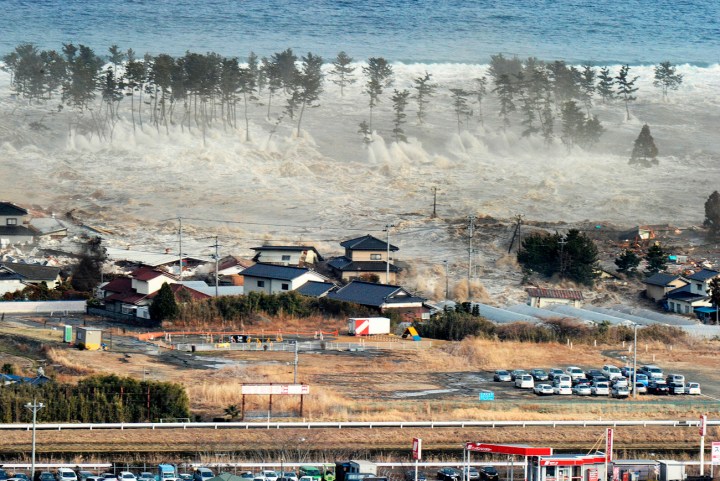Maverick Life, World
Japan, a year after the great ‘harbour wave’

They call it the Great East Japan Earthquake – though the quake itself didn’t do the most damage. It was the water and the tsunamis and the lingering nuclear spectre that have hurt worst. By REBECCA DAVIS.
The events of 11 March 2011 unfolded like falling dominos. It started with one of the five most powerful earthquakes to strike the world since modern record-keeping – a magnitude 9.0 on the Richter Scale – 70km off the coast of Japan at 14:46 Japanese Standard Time. The earthquake triggered a series of tsunamis (the Japanese word means “harbour wave”) with towering waves of up to 40m. The tsunamis pushed billions of tons of water as far as 10km inland. It also caused the meltdown of three reactors in the Fukushima Daiichi Nuclear Power Plant. Nearly 16,000 people have been confirmed dead and 3,300 others are still classified as missing, but presumed dead.
“There was a terribly sombre public mood hanging over Japan after the events of 11 March,” Nevenka Ristic, a 31-year-old South African who was living in Osaka at the time, told the Daily Maverick. “At first it wasn’t quite clear just how serious the situation was, but when word spread as to the severity, there was very much the sense of a nation in mourning, even in areas far removed from the affected region.”
The three-pronged disaster destroyed Japan’s north-east coast, but the country’s national psyche also took a battering. A 58-year-old teacher told The Telegraph: “In some ways, things are worse today in Japan than after the World War II”. One of the casualties of the disaster was Prime Minister Naoto Kan, forced to step down in the aftermath after being accused of not having dealt with matters adequately.
Today, reconstruction efforts remain not only unfinished, but in many areas, not even begun. Residents’ squabbling over rebuilding plans has left many reconstruction budgets unspent and a reconstruction agency aimed at expediting the re-building process only launched last month. In the face of this failure to act, the north-east has seen an exodus of young people seeking jobs in bigger cities, like Tokyo.
There are other problems: 23-million tons of debris are still lying around the north-east coast, with only 6% of it disposed of to date, largely due to a reluctance to bury it for fear of possible radioactive contamination. There are also more than 320,000 displaced people still living in temporary housing. And some of the effects of the disaster have been less visible. Japan saw an increase in suicide rates of 20% in the months after the disaster over those of the year before. Causes were identified as post-traumatic stress disorder and “survivors’ guilt” in some cases. In one particularly poignant incident, reported by the Japan Times, a dairy farmer in Soma, Fukushima Prefecture, chalked a note on the wall of his cattle shed: “If only there wasn’t a nuclear power plant”. He had had to kill all his cows after milk shipments from the area were disallowed. Then he killed himself.
Although nobody died as a direct result of the nuclear accidents, it is this component of the disaster that has received the most attention in the year since. This is likely as a result of the cultural fascination and fear attached to nuclear power plants ever since the Chernobyl disaster in Ukraine in 1986. Chernobyl and Fukushima share the distinction of being the only two power plant accidents in history classified as “level 7 events” on the International Nuclear Event Scale.
The Fukushima disaster was less serious than Chernobyl mainly because the plant’s reactor core was not exposed to the air. Japanese authorities also dealt with the situation better because, unlike in the Ukrainian case, they were not silenced by Soviet-style secrecy and cover-ups at all costs, and communicated clearly with the local residents. “They didn’t treat their population like idiots like ours did,” Ukrainian nuclear engineer Ilgiz Iskhatov told Newsweek after the accident last year. The contamination zone from Chernobyl will remain dangerous for thousands of years. In Fukushima’s case, nuclear experts expect decontamination to take about 30 years. Ukrainian nuclear experts have now warned Japan, however, that it needs to clear up radioactive contamination before this year’s spring rains start.
What the Fukushima disaster proved very starkly was exactly how vulnerable nuclear power facilities are to climate change and natural disasters: a notion that had not been adequately considered beforehand. And it’s not just earthquakes and tsunamis that could spark this kind of accident. The Huffington Post quoted researchers at the US National Resources Defence Council that hurricanes, tornadoes and flooding could cause the same kind of damage as in Japan.

Photo: A man looks for his photographs at a collection centre for items which were found in the rubble of an area devastated by the 11 March 2011 earthquake and tsunami in Sendai, Miyagi prefecture 9 March 2012, ahead of the one-year anniversary of last March 11 earthquake and tsunami. More than 250,000 photographs and personal belongings are displayed at the centre for owners to recover. REUTERS/Toru Hanai.
On the one-year anniversary of the disaster on Sunday, the president of the plant’s parent company, the Tokyo Electric Power Company (Tepco), Toshio Nishizawa, expressed his “heartfelt” sympathy around the disaster. “The day of 11 March is forever etched on the hearts and minds of every Tepco employee,” Nishizawa said. As part of its positive PR project, it allowed reporters and foreign dignitaries to enter the crippled Fukushima plant on Sunday to witness the work being carried out. Last year Tepco enlisted top government officials to participate in publicity stunts to highlight the efficacy of their decontamination procedures.
In one such extraordinary exercise, Japanese MP, Yasuhiro Sonoda, had to publically drink water from inside the nuclear power plant to prove its safety. In November, Sonoda undertook to take up the challenge posed by journalists, and at a televised press conference, drank a glass of water scooped up from pools inside the nuclear plant. Sonoda’s hands visibly shook as he downed the glass of water. Earlier the same year, former prime minister Naoto Kan and chief government spokesman Yukio Edano both ate food produced within the Fukushima prefecture in a bid to persuade the public that it was safe.
But, however many stunts of this type take place, they cannot change the fact that radioactive readings in certain reactors of the plant are still frighteningly high. A reading undertaken by a robot in one reactor recently found that the radioactive levels were still as high as 220mSv/h (millisievert an hour). To put this in perspective, most people are exposed to natural radiation at the rate of 2-3mSv a year.
In the wake of the disaster, it is unsurprising that the Fukushima disaster has dented the public appetite for nuclear energy in Japan. On Sunday about 8,000 people attended an anti-nuclear demonstration in Tokyo. They joined anti-nuclear protesters all over the world, who used the week as an opportunity to rally to express their misgivings about nuclear power. Last week Cape Town Greenpeace activists staged a mock radioactive spill on a beach in Sea Point, leaving barrels marked as containing radioactive materials along the sand as if they had washed up. “The idea was to create a sense of what a nuclear accident could look like,” one activist said. Joggers along the Sea Point promenade were reportedly surprised and alarmed to witness the scene, but activists were on hand to distribute flyers and explain their view that “nuclear is not the answer South Africa is looking for, and it has no place in a green, sustainable future”.
Greenpeace’s report on the Japanese disaster, entitled “Lessons from Fukushima”, says “the key causes of the nuclear accident lie in the institutional failures of political influence and industry-led regulation. It was a failure of human institutions to acknowledge real reactor risks, a failure to establish and enforce appropriate nuclear safety standards and a failure ultimately to protect the public and the environment.” The report makes for sobering reading, but the enthusiasm for nuclear power from global governments seems undimmed. In 2011 alone, 60 countries approached the International Atomic Energy Agency – the UN’s nuclear watchdog – with an eye to starting nuclear programmes: including Vietnam, Turkey and the UAE.
In Japan, meanwhile, the long, hard road towards recovery is still being walked. It is estimated it will cost Japanese taxpayers more than $230-billion to rebuild cities, towns and villages on higher ground over the next 10 years. Amid all the devastation and heartbreak, the famous Japanese spirit of resilience and honour remains: the Japanese public returned a total of $78-million in missing cash and safes they had found to police in the months after 11 March last year. DM
Read more:
- Japan marks first anniversary of earthquake and tsunami, in the Guardian.
Photo: The tsunamis with towering waves of up to 40m left devastation in their wake. REUTERS.


















 Become an Insider
Become an Insider